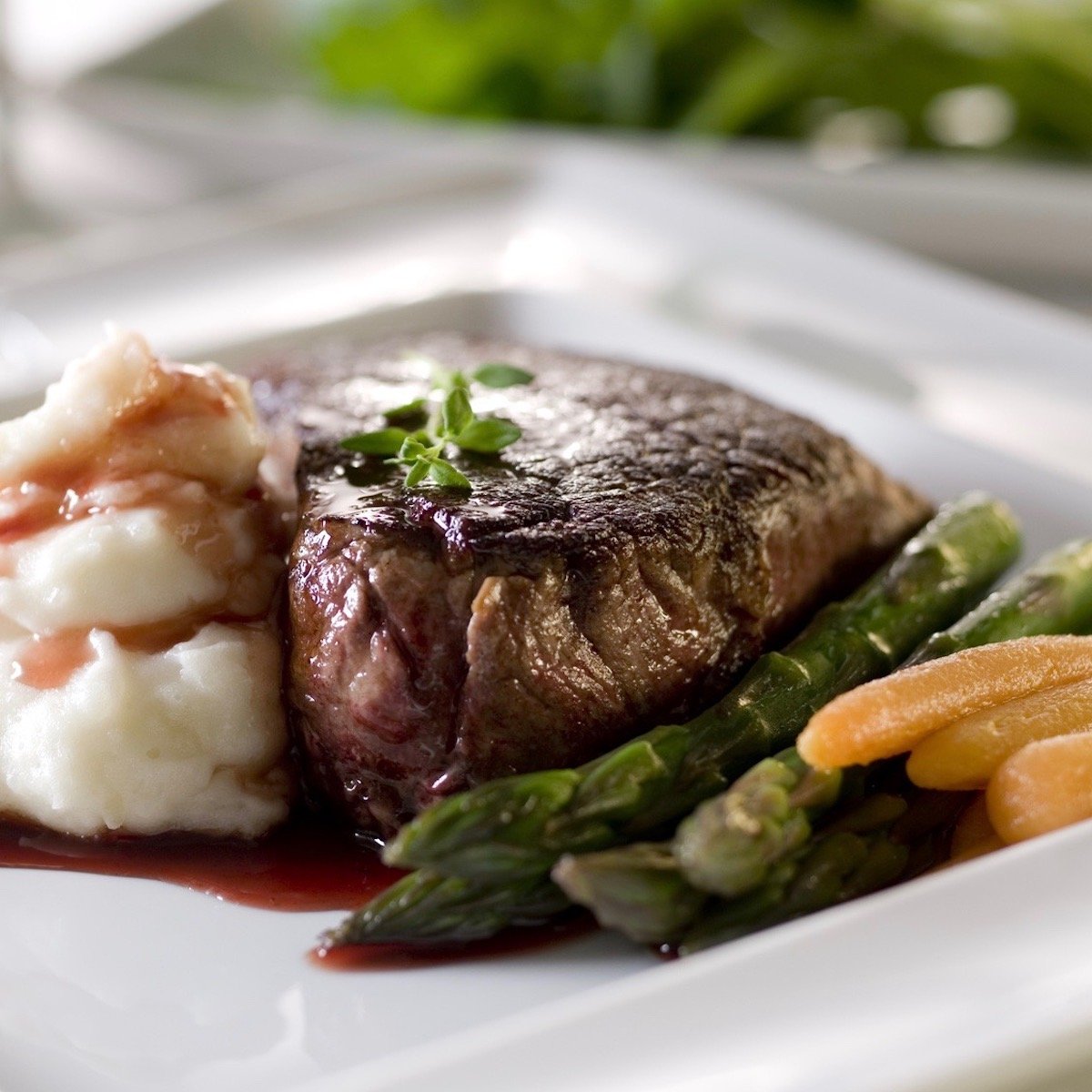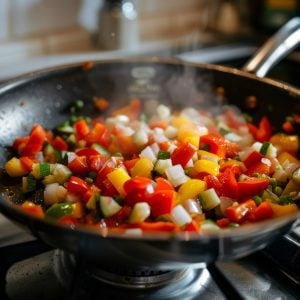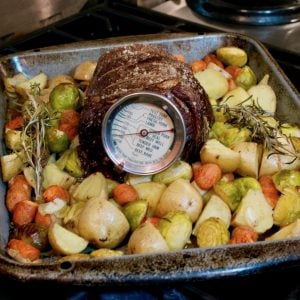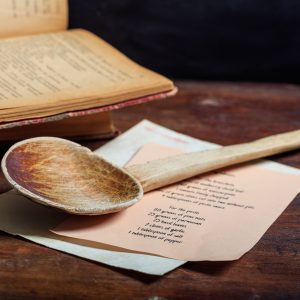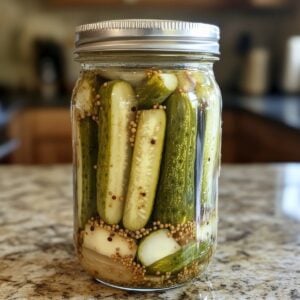How you can prepare great sauces at home.
Now that we have looked at some of the important ingredients used for restaurant-quality sauces let’s look at a few vital cooking techniques associated with sauce making.
Learning the techniques of preparing sauces is crucial for anyone interested in cooking, as it enhances flavor, versatility, customization, and creativity in the kitchen, while also contributing to a solid foundation in culinary skills.
This is not a complete list. Some great saucing cookbooks go into much more detail, but these are the techniques you’ll need for making the sauces on my site.
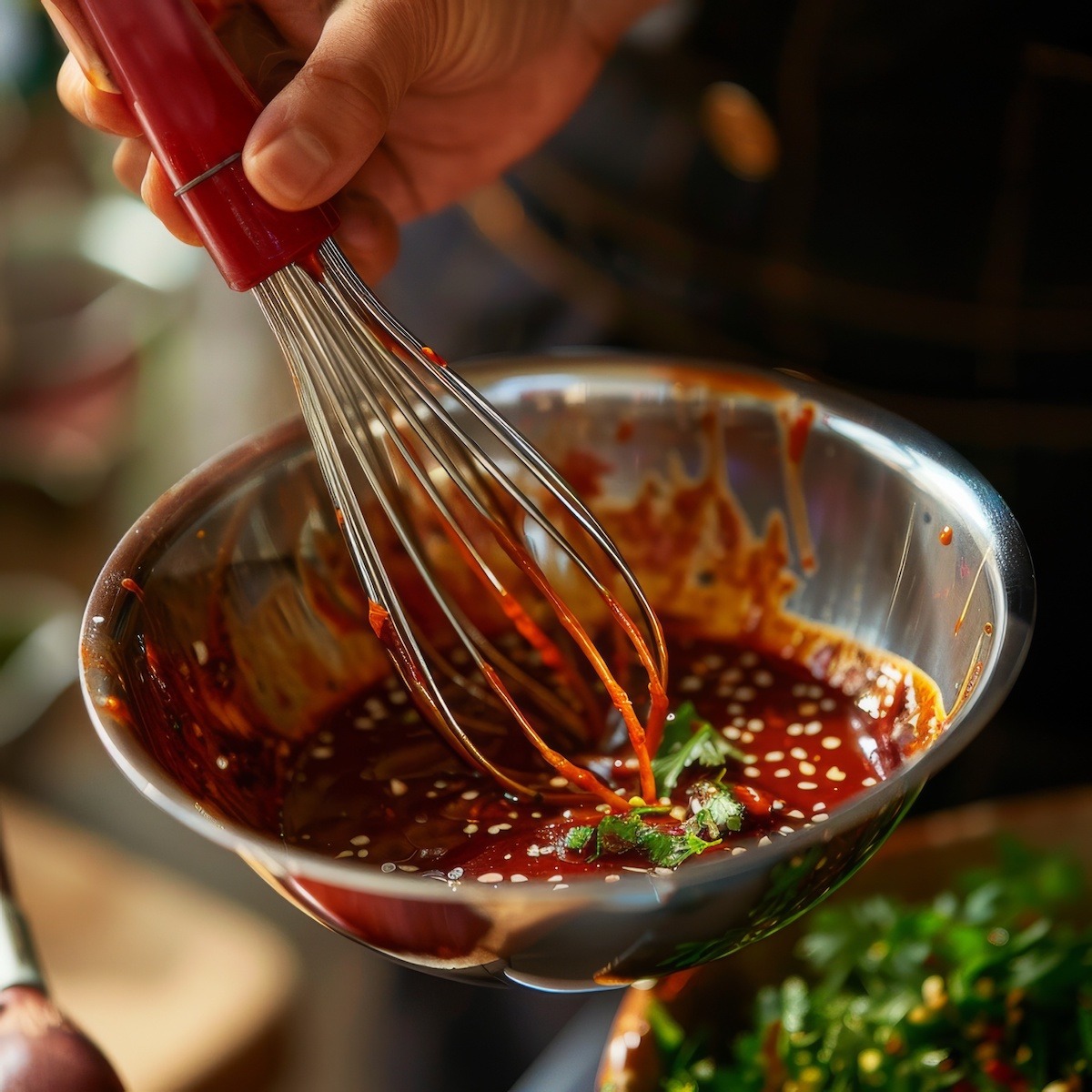
How to Emulsify
Emulsifying a sauce refers to the process of creating a stable mixture of two immiscible liquids, typically oil and water, that would normally separate. The goal is to form a homogeneous and uniform blend, producing a smooth, well-integrated sauce.
The key to emulsification is using an emulsifying agent, which helps disperse and stabilize the tiny droplets of one liquid within the other.
In the context of sauces, the most common type of emulsion is an oil-in-water emulsion, where oil is dispersed in water. Examples of emulsified sauces include vinaigrettes, mayonnaise, and hollandaise sauce.
The basic process of emulsification involves the following steps:
Emulsifying Agent: An emulsifying agent is needed to stabilize the mixture and prevent the separated liquids from recombining. Common emulsifying agents include egg yolks, mustard, lecithin (found in egg yolks and some plant sources), and certain proteins.
Mechanical Agitation: The emulsion is created by mechanically agitating the two immiscible liquids together. This can be done through techniques such as whisking, blending, or using a food processor. The agitation breaks down the larger droplets into smaller ones and disperses them throughout the liquid.
Gradual Incorporation: Adding one liquid (usually the oil) gradually to the other (usually the water) while continuously whisking or blending is essential. This slow incorporation allows the emulsifying agent to surround and stabilize the tiny droplets of the dispersed liquid.
Proper Ratios: Achieving a stable emulsion also depends on the proper ratio of oil to water and the right amount of emulsifying agent. Too much or too little of any component can result in a broken emulsion, where the liquids separate.
Temperature Control: The temperature of the ingredients can also impact emulsification. For example, in the case of mayonnaise, having the egg yolk and oil at a similar temperature can promote a more stable emulsion.
Common emulsified sauces and dressings that involve this process include mayonnaise, vinaigrettes, certain types of salad dressings, and hollandaise sauce. Emulsification is a fundamental culinary technique that adds texture, creaminess, and stability to various sauces.
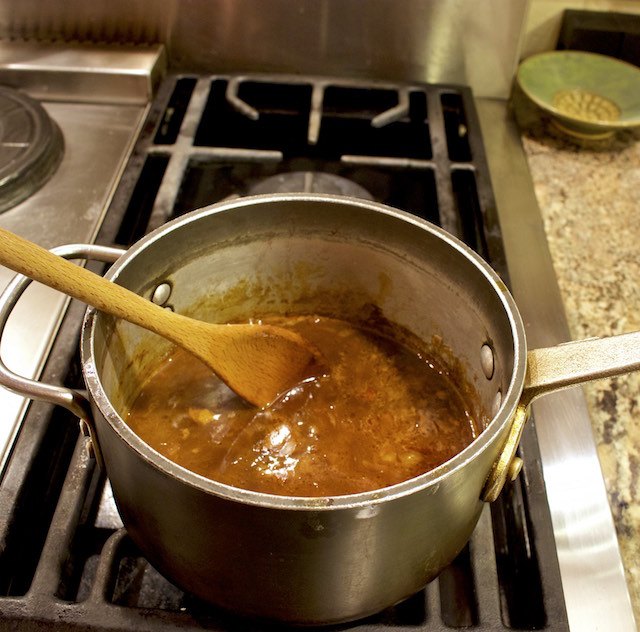
How to Reduce
Sauce reduction is a culinary technique where a liquid component of a sauce is simmered or boiled to evaporate water content, resulting in a thicker and more concentrated mixture. This process enhances the sauce’s flavor, thickness, and overall richness. Reduction is a common method used to intensify the taste of a sauce and create a more desirable texture.
Here’s an overview of the sauce reduction process:
- Start with a Liquid Base: The sauce typically begins with a liquid base, including broth, wine, vinegar, cream, or other flavorful liquids.
- Heat and Simmer: The liquid is heated and brought to a simmer or gentle boil. Simmering allows the water content in the liquid to evaporate, concentrating the flavors.
- Evaporation of Water: As the sauce simmers, water evaporates, leaving behind a thicker, more flavorful sauce. The goal is to achieve the desired consistency while intensifying the taste.
- Watch for Consistency: It’s important to monitor the reduction process carefully to prevent over-reduction, which can result in a sauce that is too thick or intense. The sauce should coat the back of a spoon, indicating it has reached the desired thickness.
- Flavor Enhancement: Reduction thickens the sauce and intensifies its flavor. This is because as water evaporates, the remaining components become more concentrated. The process can enhance the complexity and richness of the sauce.
Common sauces that often involve reduction include:
- Demiglace: A classic French sauce that reduces brown stock (beef or veal) to a thick, concentrated consistency. It’s used as a base for many other sauces.
- Balsamic Reduction: Balsamic vinegar is simmered and reduced to create a thicker, syrupy sauce with a sweet and tangy flavor.
- Pan Sauce: After cooking meat in a pan, a reduction of wine, broth, or other liquids is often made to create a flavorful sauce to accompany the dish.
- Reduction in Stir-Fry Sauces: In Asian cuisine, sauce reduction is often part of the stir-frying process, creating a thicker and more flavorful sauce to coat the ingredients.
Sauce reduction is a versatile technique used in various cuisines to elevate the taste and texture of dishes, providing a concentrated and well-balanced flavor profile.
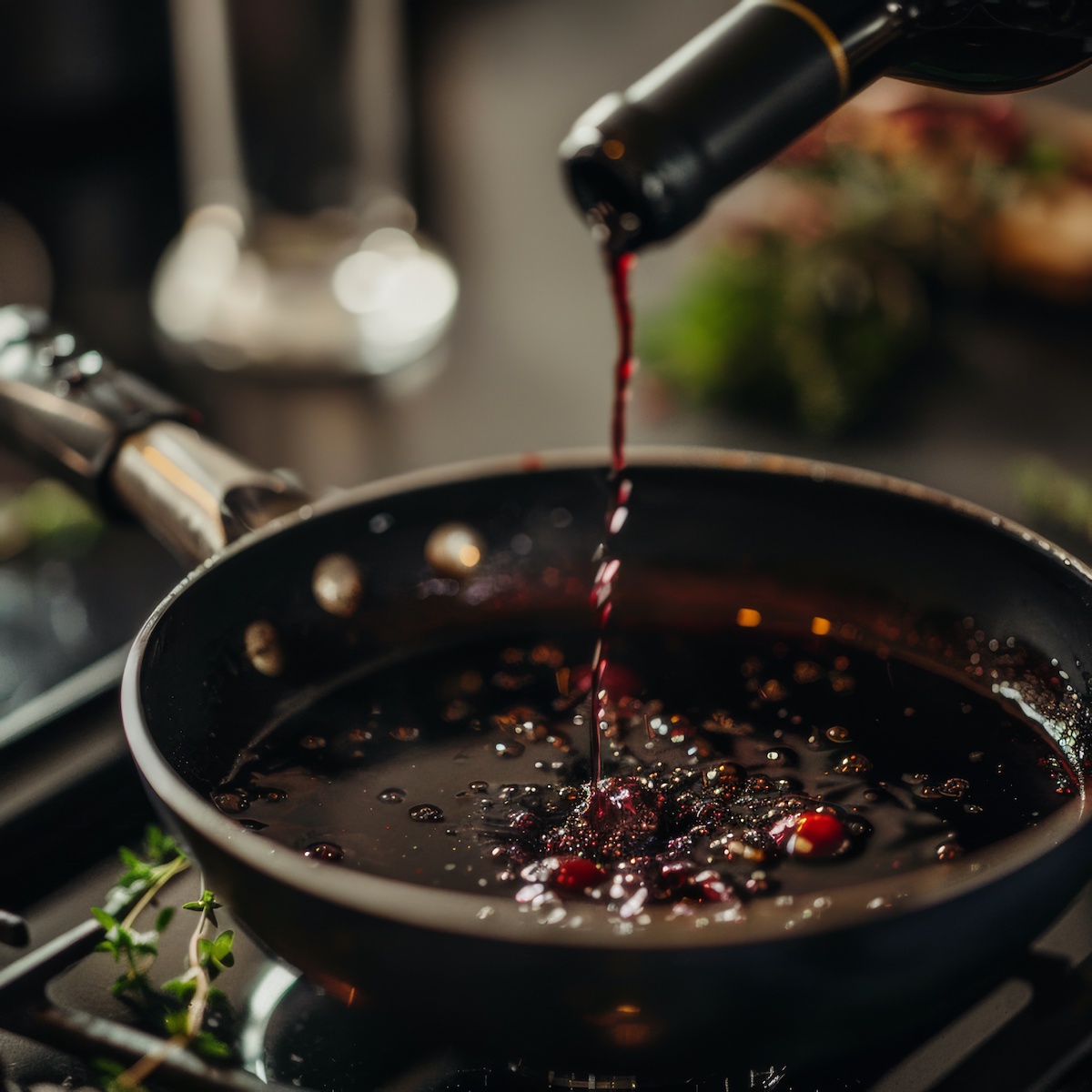
How to Deglaze
Deglazing a pan is a cooking technique that involves adding liquid to a hot pan to loosen and dissolve the flavorful browned bits (fond) that have stuck to the bottom during the cooking process.
These browned bits are rich in flavor and are a result of caramelization and Maillard reactions, contributing depth and complexity to the dish. Deglazing is often done after sautéing or searing meat, poultry, or vegetables.
By the way, another term for fond in cooking is “sucs.” Both terms refer to the flavorful browned bits that develop on the bottom of a pan during the cooking process, particularly when searing or sautéing meat or vegetables.
Here’s how the deglazing process typically works:
Cooking Ingredients: Begin by cooking your main ingredients (such as meat or vegetables) in a hot pan. The high heat promotes browning, creating flavorful fond on the bottom of the pan.
Remove the Main Ingredients: Once the main ingredients are cooked, remove them from the pan. This step is essential as it allows you to access the fond at the bottom of the pan.
Add Liquid: Pour a liquid into the hot pan. Common liquids used for deglazing include wine, broth, stock, vinegar, or even water. The liquid helps to lift and dissolve the flavorful bits stuck to the pan.
Scraping the Pan: As the liquid heats up, use a spatula or a wooden spoon to scrape the bottom of the pan. This action helps to release the fond and incorporate it into the liquid. The process is often accompanied by a sizzling sound.
Creating a Sauce: The liquid, now infused with the dissolved browned bits, can be reduced to create a flavorful sauce. The resulting sauce can be poured over the main ingredients or used as a base for further culinary creations.
Deglazing serves several purposes:
Flavor Enhancement: By incorporating the fond into the liquid, you capture and intensify the rich, caramelized flavors developed during the cooking process.
Pan Cleaning: Deglazing helps to clean the pan by releasing the stuck-on bits, making it easier to clean later.
Sauce Creation: The liquid obtained through deglazing can be further reduced to create a delicious sauce that complements the main dish.
This technique is widely used in various cuisines and is a fundamental step in creating flavorful and well-balanced dishes, particularly in recipes that involve pan-searing or sautéing.

How to Defat a Sauce
Defatting a sauce involves the removal of excess fat from the liquid component of a sauce. This reduces the overall fat content and makes the sauce leaner. The process is commonly applied to pan sauces, braising liquids, stocks, or other liquid-based preparations.
How to defat a sauce:
Chilling the Sauce: Allow the sauce to cool slightly, and then refrigerate it until it becomes cold. The fat in the sauce will solidify on the surface, making it easier to remove.
Skimming or Spooning Off Fat: Once the sauce has chilled, use a spoon or a fat separator to skim off the solidified fat from the surface. A fat separator is a kitchen tool designed to separate fat from liquids, typically by pouring the liquid through a spout at the bottom, which allows you to collect the fat separately.
Discarding or Reserving Fat: Dispose of the removed fat or reserve it for other uses if desired. Some cooks save rendered fat for flavoring other dishes.
Reheating the Sauce: If necessary, reheat the sauce before serving. Be cautious not to reintroduce any fat that was removed during the chilling and skimming process.
Why De-fat a Sauce?
Health Considerations: Removing excess fat from a sauce can reduce its overall calorie and fat content. For individuals who are conscious of their dietary fat intake or following a low-fat diet for health reasons, defatting allows them to enjoy flavorful sauces with less fat.
Dietary Preferences: Some people prefer lighter and less greasy sauces. Defatting accommodates different dietary preferences, making dishes more suitable for those who prefer a leaner option.
Balanced Flavors: Excessive fat in a sauce can overpower other flavors and make the dish feel heavy. Defatting helps achieve a better balance, allowing the other ingredients and flavors to shine through.
Improved Texture: Removing excess fat can result in a lighter and more refined texture for the sauce. This can be particularly important in certain dishes where a lighter consistency is desired.
Healthier Cooking Practices: Defatting aligns with healthier cooking practices, as it encourages the reduction of saturated and trans fats. This can contribute to overall heart health and better cholesterol levels.
Customization: Defatting provides the flexibility to customize the fat content of a dish. It allows cooks to adapt recipes based on their dietary goals, preferences, or the nutritional needs of those they serve.
How to De-fat a Sauce
There are several methods to defat a sauce, each offering a way to reduce the fat content while retaining the flavor.
Refrigeration and Skimming:
- Allow the sauce to cool.
- Refrigerate the sauce until the fat solidifies on the surface.
- Skim off the solidified fat using a spoon or ladle.
Using a Fat Separator:
- Pour the sauce into a fat separator while it’s still warm.
- Allow the fat to rise to the top.
- Pour the defatted liquid from the bottom spout, leaving the fat behind.
Blotting with Paper Towels:
- Place a few layers of paper towels on the surface of the sauce.
- Gently press the paper towels against the surface to absorb the excess fat.
Ladle and Tilt Method:
- Tilt the pan slightly to pool the fat on one side.
- Use a ladle to scoop and remove the accumulated fat carefully.
Using Ice Cubes:
- Drop a few ice cubes into the warm sauce.
- As the ice melts, the fat will congeal around it, making it easier to skim off.
Using a Fat Skimmer or Spoon:
- Skim the fat off the surface of the warm sauce using a fat skimmer or a large spoon.
Freezing and Skimming:
- Freeze the sauce until the fat solidifies.
- Use a knife or spoon to lift off the solidified fat.
Straining through Cheesecloth:
- Strain the sauce through a piece of cheesecloth, which can help catch and remove fine particles of fat.
Choose the method that best suits the type of sauce you’re working with and your personal preferences. Combining techniques, such as using a fat separator after refrigeration, can provide even more effective defatting.
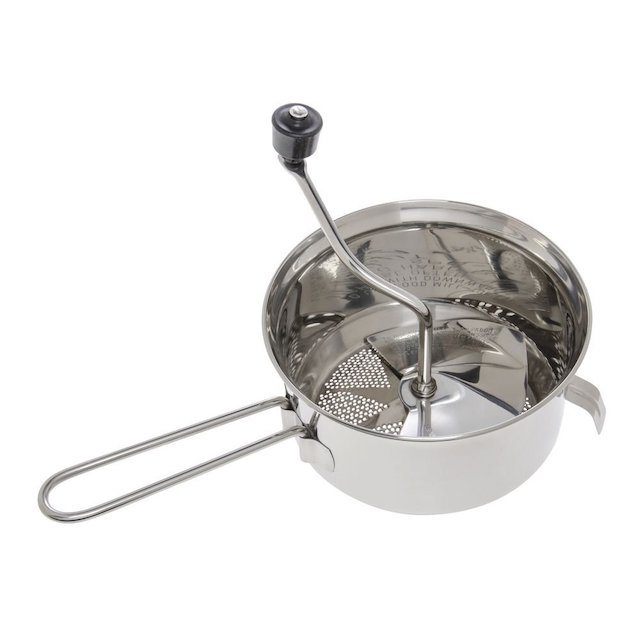
Pureeing and Straining
Pureeing and straining a sauce are culinary techniques used to achieve a smooth and refined texture in sauces, soups, or other liquid-based dishes. These processes are particularly useful when you want to remove solid particles, fibers, or seeds from the sauce, resulting in a silky, velvety consistency.
Pureeing involves using a blender, food processor, immersion blender, or similar equipment to transform the sauce into a smooth, homogenous mixture.
Process:
- Cook the ingredients until they are soft and fully cooked.
- Transfer the cooked mixture to a blender or use an immersion blender directly in the cooking pot.
- Blend the ingredients until a smooth puree is achieved.
Purpose:
- Pureeing helps break down solid components, creating a smoother texture.
- It is often used for sauces, soups, and pureed vegetable dishes.
Straining involves passing the sauce through a fine mesh strainer or cheesecloth to separate the liquid from any solid particles, creating a clear and refined liquid.
Process:
- Place a fine mesh strainer or cheesecloth over a bowl or container.
- Pour the sauce through the strainer, allowing the liquid to pass through while trapping solid particles.
- Use a spatula or the back of a spoon to press and extract as much liquid as possible from the solids.
Purpose:
- Straining is employed to remove seeds, fibers, or coarse particles, resulting in a smoother and more elegant sauce.
- It is commonly used for consommés, broths, and sauces where a clear and refined appearance is desired.
Combined Pureeing and Straining:
Process:
- After pureeing the ingredients, the resulting mixture can be strained to remove any remaining solids and achieve an even smoother consistency.
- This combined technique is often used for more delicate or refined dishes where a completely smooth texture is desired.
Both pureeing and straining are versatile techniques that allow cooks to tailor the texture of a sauce to their preferences. These methods are commonly employed in the preparation of various culinary creations, ranging from simple vegetable purees to sophisticated, clarified consommés.
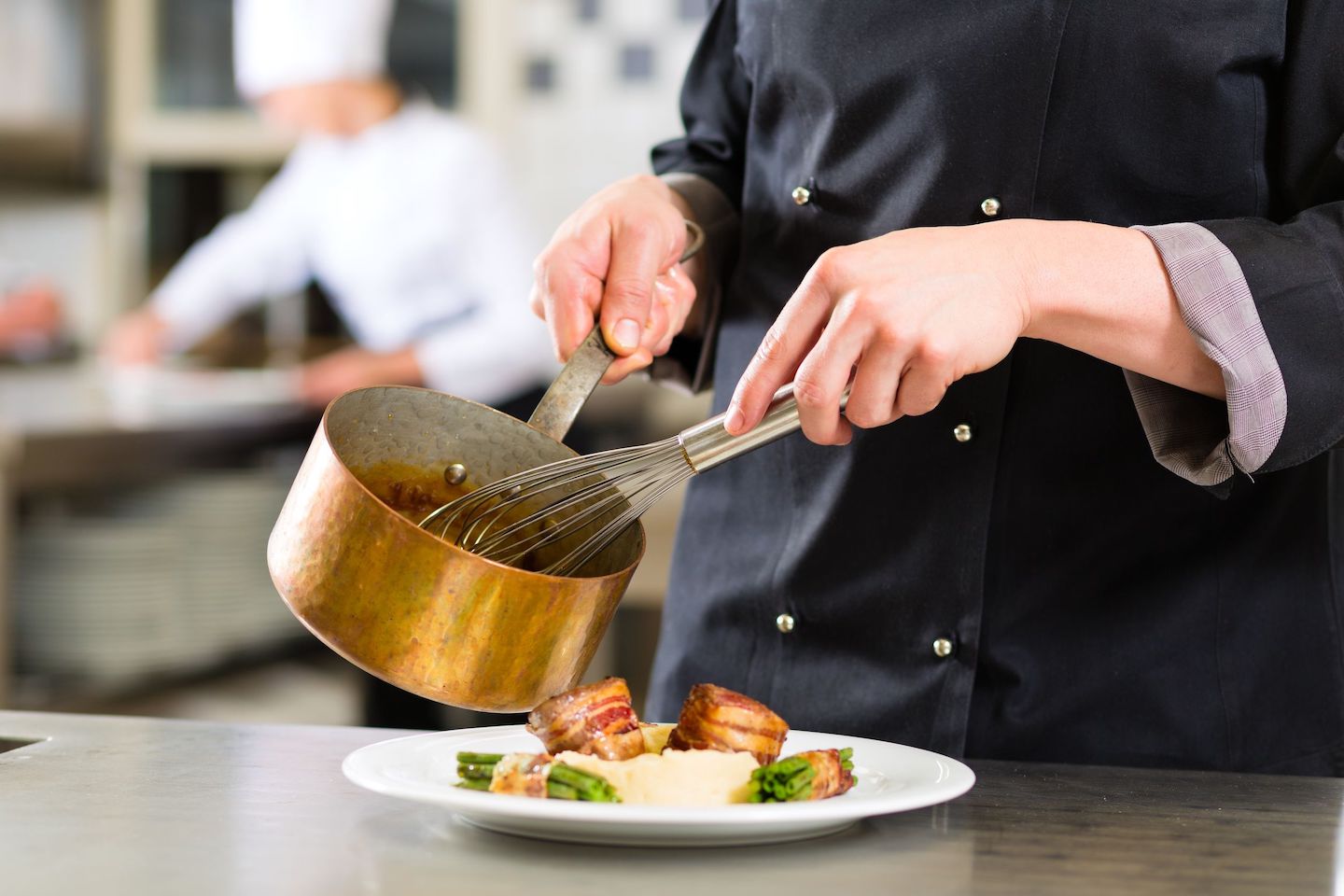
Balancing Flavors
Balancing flavors in sauce-making is the art of adjusting and harmonizing different taste elements to create a well-rounded, enjoyable, and satisfying culinary experience. The primary taste components that chefs aim to balance in sauces include sweetness, acidity, saltiness, bitterness, and umami.
Achieving balance ensures that no single flavor dominates, and the sauce complements the main dish in a harmonious way. Here’s a breakdown of each flavor component and how they contribute to balanced sauces:
Sweetness: Sweetness can come from ingredients like sugar, honey, fruits, or certain vegetables. Adds depth, rounds off sharp edges, and enhances overall flavor. It can also counterbalance acidity and bitterness.
Acidity: Acidity comes from ingredients like vinegar, citrus juices, or acidic fruits. Provides brightness, freshness, and a tangy element to cut through richness. Balancing acidity is crucial to prevent sauces from becoming overly sweet or heavy.
Saltiness: Salt is the primary source of saltiness, but sauces can also get salt from ingredients like soy sauce or certain cheeses. Enhances natural flavors, suppresses bitterness, and adds depth. Proper salt balance is essential for overall palatability.
Bitterness: Bitterness can come from certain herbs, spices, or ingredients like coffee or dark chocolate.In moderation, bitterness can add complexity and sophistication to a sauce. However, it should be balanced to prevent an unpleasant and overpowering taste.
Umami: Umami is the savory taste found in ingredients like soy sauce, tomatoes, mushrooms, or certain meats.
Adds depth, richness, and a savory quality. Balancing umami ensures a satisfying and full-bodied flavor profile.
Tips for Balancing Flavors in Sauces:
Taste as You Go: Regularly taste the sauce as it cooks and adjust the flavors gradually. This allows you to catch imbalances early in the process.
Start with a Base: Begin with a well-balanced base, and then adjust individual components as needed. For example, if a sauce is too sweet, you can counterbalance it with acidity or saltiness.
Consider the Main Dish: The flavors in the sauce should complement the main dish. Consider the overall flavor profile you want to achieve when balancing individual elements.
Use Ingredients Mindfully: Be aware of the flavors that each ingredient contributes. Adjust quantities to achieve the desired balance without overwhelming any particular taste.
Achieving balance is a subjective and creative process, and experienced chefs often rely on their palate and intuition to create sauces that enhance and elevate the overall dining experience.
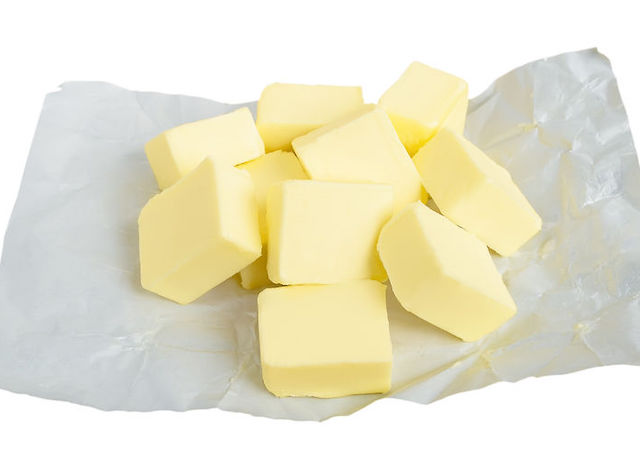
Finishing a Sauce
Finishing a sauce is the final step in the cooking process where you make adjustments, add final touches, and ensure that the flavors are balanced and harmonious. The goal is to bring the sauce to its desired consistency, taste, and texture.
Reduction alone can leave a sauce tasting a little one-dimensional. Before a reduction sauce is genuinely done, a chef knows to swirl in just a bit of heavy cream, cool butter, or compound butter (butter kneaded together with other flavoring agents, such as fresh herbs, spices, citrus zest, etc.) to create a more mellow and well-rounded flavor profile and to enrich a sauce for a more luxurious mouthfeel.
Here are common techniques used to finish sauces:
Adjusting Seasoning: Taste the sauce and adjust the seasoning as needed. This might involve adding more salt, pepper, or other seasonings to achieve the desired flavor profile.
Balancing Flavors: Check for a balanced combination of sweetness, acidity, saltiness, bitterness, and umami. Make any necessary adjustments to ensure that no single flavor dominates.
Reducing or Thinning: If the sauce is too thin, you can simmer it longer to reduce and thicken. Conversely, if it’s too thick, you can thin it with additional liquid (such as broth, water, or wine).
Straining or Pureeing: Strain the sauce to remove any remaining solids, creating a smoother texture. Alternatively, you can use a blender or immersion blender to puree the sauce for a silky consistency.
Mounting with Butter or Cream: To add richness and a luxurious mouthfeel, you can finish a sauce by mounting it with cold butter or incorporating cream. This step is often called “monter au beurre” in French culinary terminology.
Adding Fresh Herbs or Aromatics: Stir in fresh herbs or aromatics at the end of the cooking process to impart a burst of fresh flavor. Common choices include parsley, chives, basil, or a splash of fresh lemon juice.
Adjusting Texture with Roux or Cornstarch: If needed, you can adjust the sauce’s thickness by incorporating a roux (a mixture of flour and fat) or creating a slurry with cornstarch and water. Be sure to cook the sauce for a few additional minutes to remove the raw taste of the thickening agent.
Finishing with High-Quality Ingredients: Elevate the sauce by finishing with high-quality ingredients, such as a drizzle of extra-virgin olive oil, a sprinkle of grated Parmesan cheese, or a dash of truffle oil.
Strategic Seasoning: Consider strategic seasoning just before serving. Some ingredients, like fresh herbs, can lose their potency when cooked for too long. Add them towards the end for maximum flavor impact.
Resting Before Serving:
Allow the sauce to rest for a few minutes before serving. This helps the flavors meld and ensures that the sauce is at its peak when presented.
The finishing touches to a sauce often depend on the type of sauce you’re preparing and the desired flavor profile. Experimentation and tasting as you go are key elements in perfecting the finishing process.
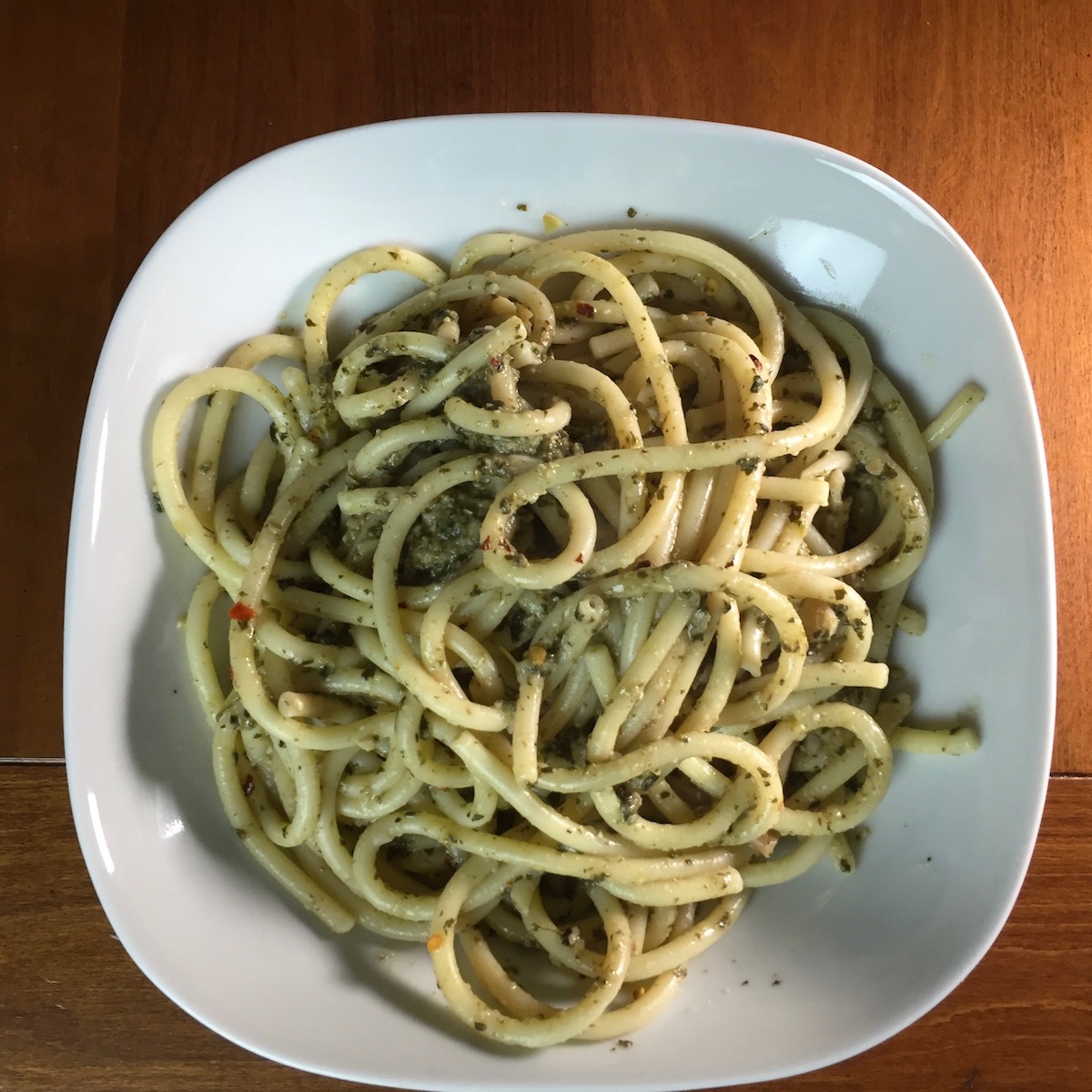
How to Finish Pasta
Once you have made a beautiful pasta sauce, it’s not enough to ladle some onto your noodles. The Italians have a secret way of adding sauce to pasta so that the flavors blend and complement each other.
Before draining the pasta, reserve about 1/4 cup of the pasta cooking liquid. This contains many starches and some salt (you do salt the pasta cooking water, right?)
Drain the pasta and return it to the pan over high heat. Add the reserved cooking liquid and several ladles of the sauce. Also, add just a tablespoon or so of fat–butter, olive oil, finely grated hard cheese, or some heavy cream, depending on what kind of sauce you have made.
Stir well over high heat until the sauce has thickened and coated all the pasta.
Serve on warmed plates, and spoon onto the dressed pasta as much of the reserved sauce as you’d like.
Since the water contains starch, it will help thicken the sauce, allowing it to cling to each noodle. As you stir in the additional fat and starchy water, you create an emulsion, and your sauce will develop a silkiness without this step.

Heating or Chilling the Plates
When you go to a restaurant and are served your food, the server often cautions, “Careful. The plate is a little hot.” Sometimes they even serve you with oven mitts on.
And, when you get a salad in a nice restaurant, the plate is generally chilled. The reason for this is simple. Hot plates keep hot food hot, and cold plates keep cold food cold.
Serving a salad on a plate still hot from the dishwasher heats up the greens and the dressing that is in contact with the plate, and you end up with wilted lettuce and warm dressing. Yuck.
And serving a sauced main dish, like a steak au poivre, Pasta Bolognese, or even turkey with gravy, on a cold plate does nothing but chill the sauce the moment it hits the plate.
Please don’t spend the time it takes to make a restaurant-quality sauce only to serve it at the wrong temperature. Instead, take a page from the Restaurant Book of Secrets and serve chilled foods on chilled plates and hot foods on warm plates. It might be a small thing, but it has a significant impact.

